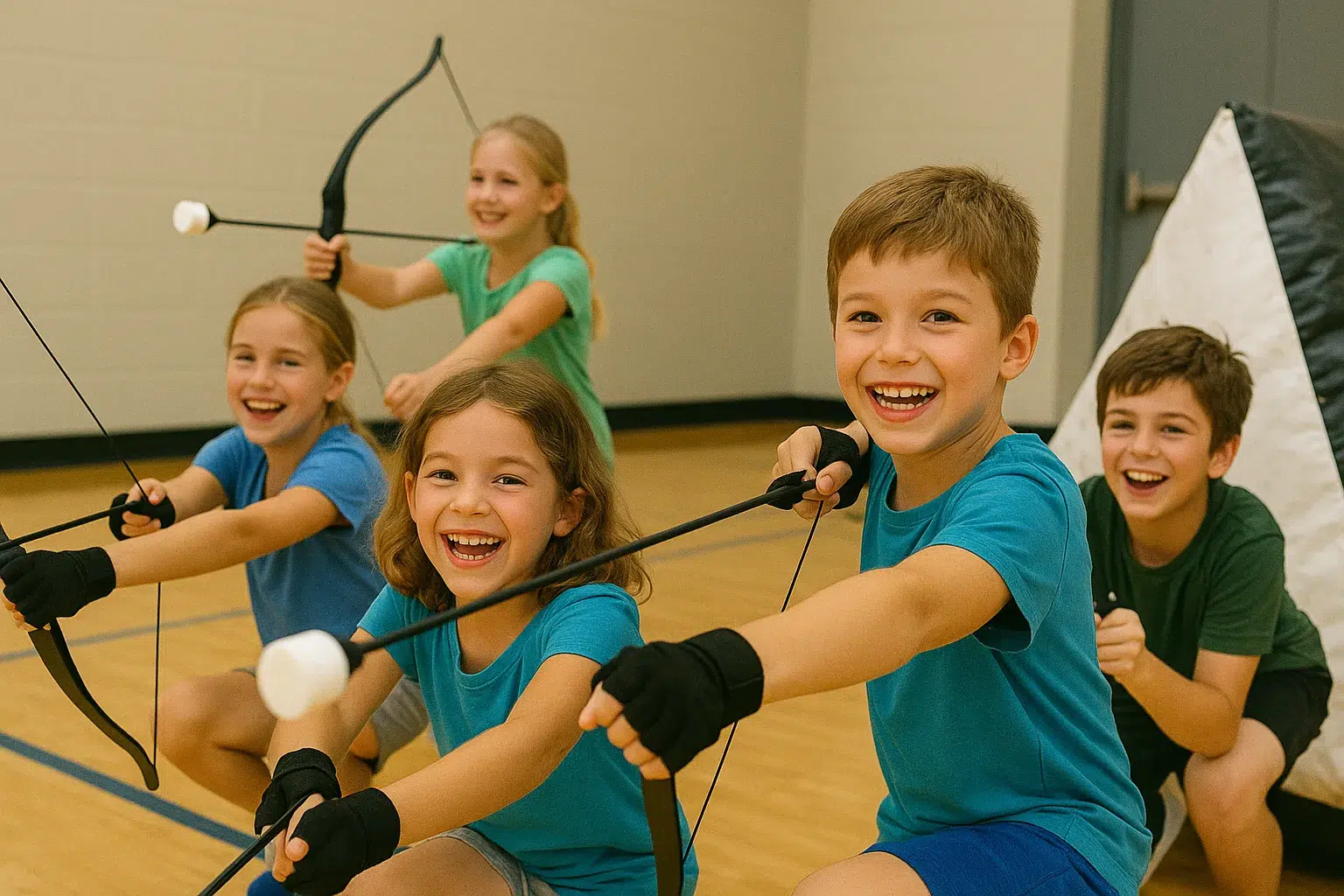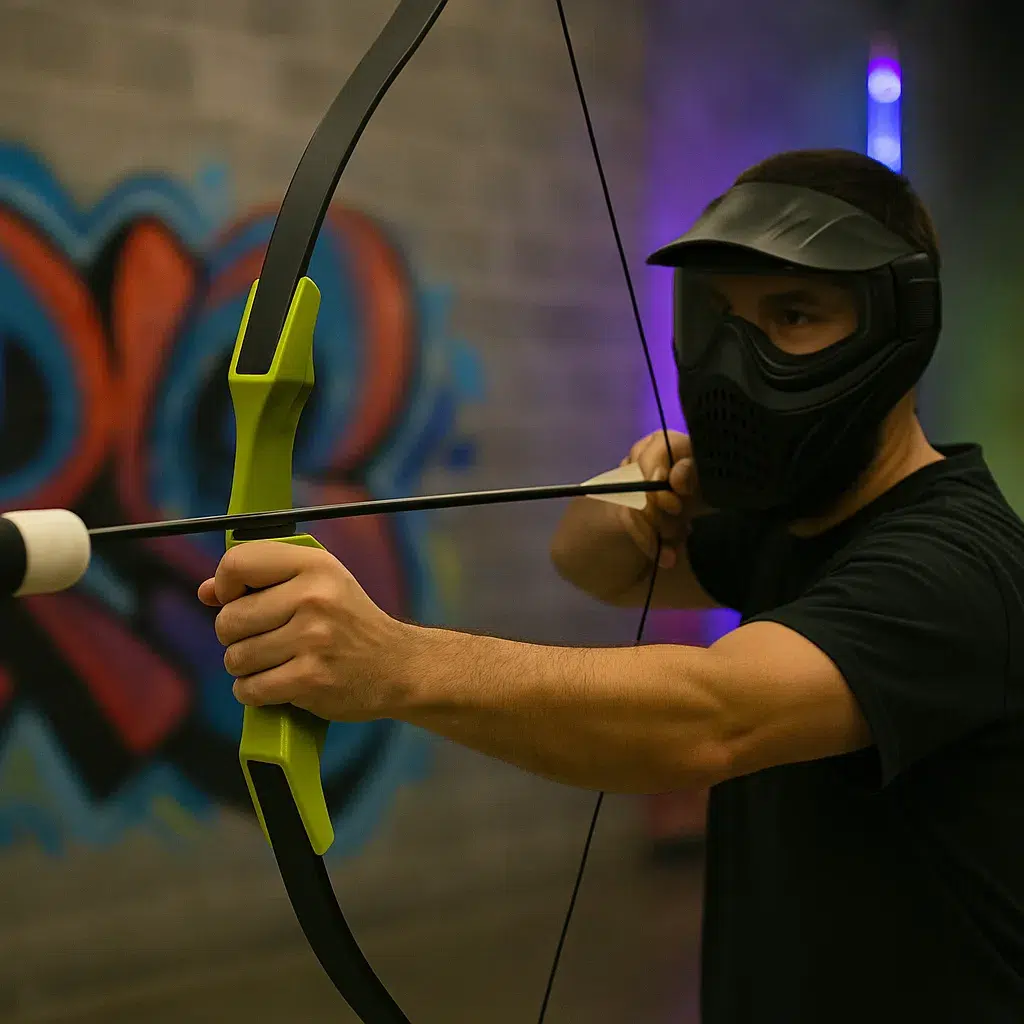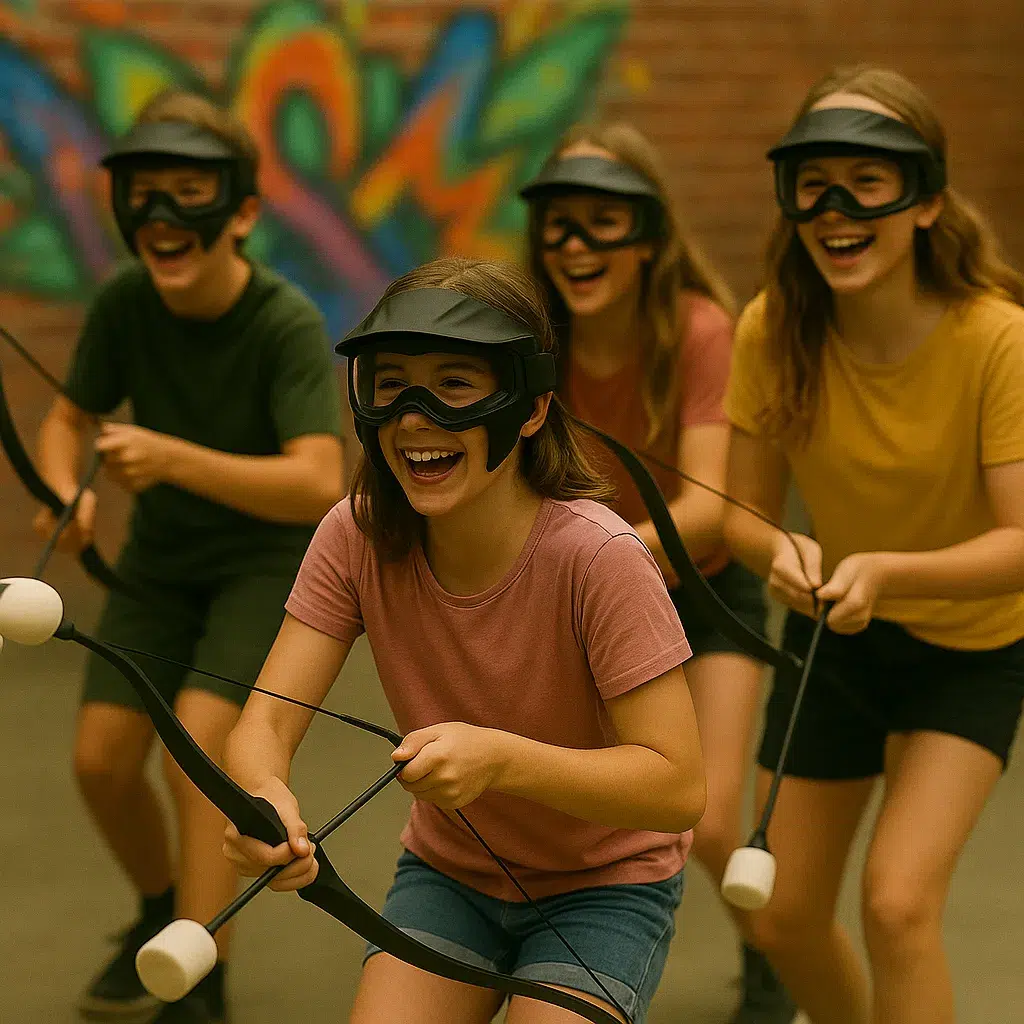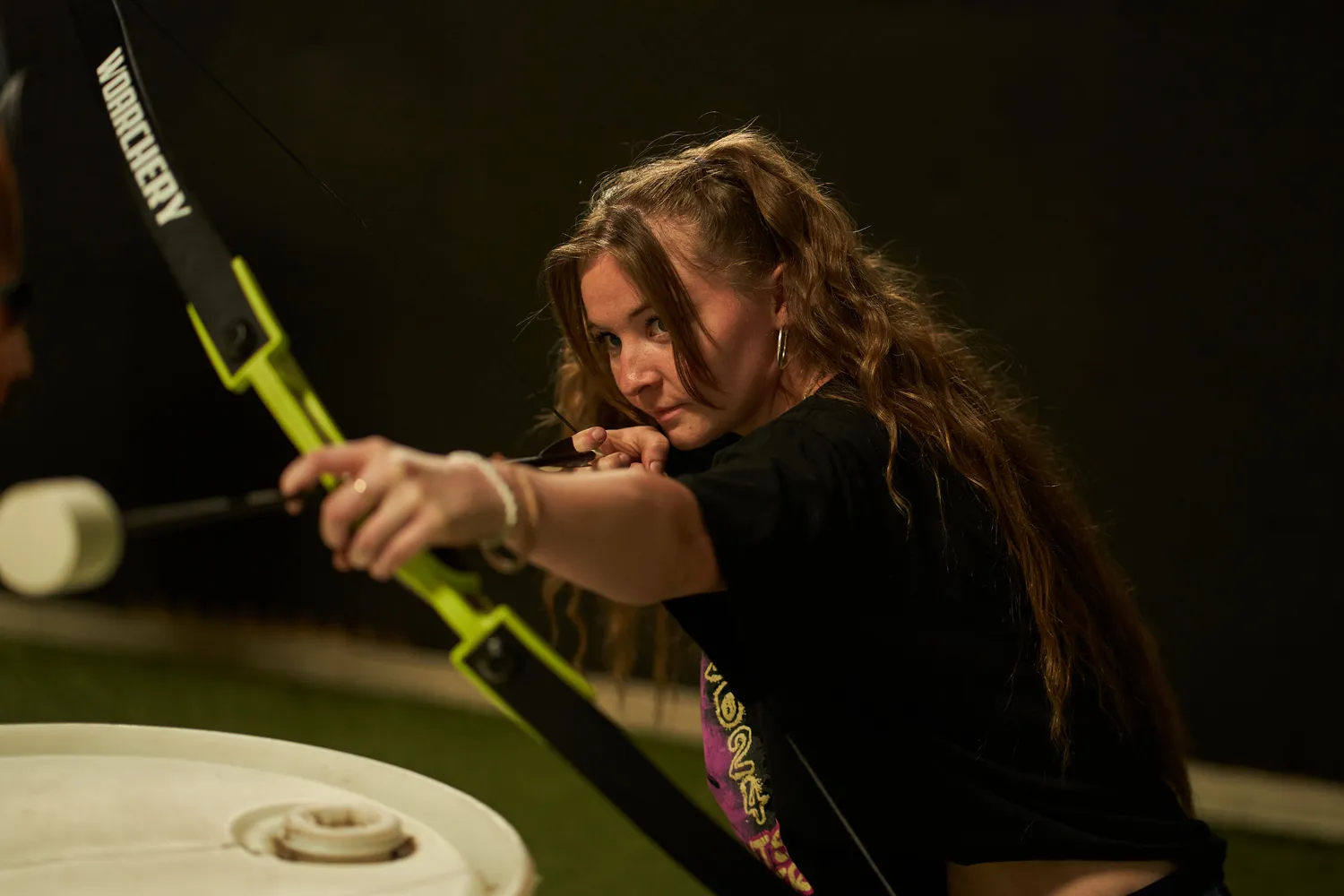At Brainy Actz, Archery Arrow Tag offers more than just adrenaline-pumping action—it provides an inclusive and safe environment where participants of all ages can thrive. As interest in this high-energy activity grows among families, school groups, and corporate teams, understanding the right age categories becomes essential. From choosing age-appropriate equipment to adapting game rules for younger players, Brainy Actz ensures that every session balances fun, skill development, and safety. By aligning physical readiness, mental focus, and game dynamics, the experience becomes both thrilling and age-appropriate for all.
Key Takeaways
- Most players can begin safely participating in Archery Arrow Tag around age 8, given their motor skill development.
- Protective gear like facemasks, armguards, and chest protectors must be appropriately sized for different age groups.
- Rule modifications, safe zones, and simplified objectives help younger players stay safe and engaged.
- Small instructor-to-player ratios and pre-game briefings enhance safety and learning for youth.
- Brainy Actz ensures age-based protocols, supervision, and equipment adjustments are in place to promote safe, memorable gameplay for all participants.
Determining Suitable Age Categories for Archery Arrow Tag Participation

Archery Arrow Tag participation is most effective when players are matched with activities that fit their age, physical capabilities, and cognitive development. This ensures a safe and enjoyable experience for everyone involved. The game’s fast-paced, team-focused format requires coordination and spatial awareness, which vary across age groups. Adapting rules, equipment, and guidance based on age helps create inclusive and effective gameplay. Organizers must assess readiness holistically to deliver rewarding, risk-free sessions for all players.
Minimum Age Recommendations for Safe Archery Arrow Tag Engagement
Most environments recommend age 8 as the starting point for participants due to developmental milestones in motor skills and focus. Children around this age typically demonstrate the balance and coordination required to move safely and respond during active play. Foam-tipped arrows and lightweight bows make the experience approachable for beginners. At this age, players can follow basic instructions with supervision. These guidelines reduce the likelihood of accidents during sessions. Facilitators may also offer age-specific adjustments to ease younger players into gameplay. Early exposure helps develop comfort with equipment and team interaction.
Physical Maturity Levels Appropriate for Archery Arrow Tag
Physical readiness plays a vital role in maintaining safety during archery tag matches. Children from 8 to 12 generally have the strength to handle bow tension and sprint across the arena. As participants mature, their agility, speed, and coordination improve, making gameplay more fluid. Teenagers and adults tend to perform high-intensity moves like dodging and quick take-offs with ease. Organizers should consider these factors when forming teams. Matching physical capacity ensures fair play and limits overexertion. Ongoing assessments help align player capabilities with the pace of the game. Proper warm-ups also support readiness across ages.
Cognitive Abilities Needed for Understanding Archery Arrow Tag Rules by Age
Participants must grasp safety protocols, team roles, and basic strategy to play effectively. Most children aged 8–12 can comprehend simplified rules and demonstrate rule-following through repetition and modeling. Clear instruction and visual aids improve their understanding of boundaries and fair play. Older players can process more complex strategies and game dynamics. Coaches should adapt language and teaching styles to match comprehension levels. Verifying understanding before each match ensures smoother execution. Reinforcing key rules during gameplay supports consistency. Engagement increases when participants feel confident in following structure.
Required Safety Equipment Tailored to Various Age Groups

Proper safety gear is essential in Archery Arrow Tag to prevent injury and ensure an enjoyable experience across all age groups. As participants vary in size, strength, and responsiveness, their equipment must be matched accordingly. Protective gear such as facemasks, chest protectors, and armguards plays a vital role in supporting safe gameplay. When properly fitted, these items boost confidence and reduce hesitation, especially among younger players. Regular inspection and maintenance help maintain safety standards throughout repeated use. Tailored equipment ensures that players of all ages remain protected while fully engaging in the action.
Selecting Correctly Sized Protective Facemasks for Younger Players
Younger players benefit from lightweight facemasks that provide full-face coverage without obstructing vision. These masks should include adjustable straps to ensure a snug, comfortable fit. When worn correctly, they reduce the risk of facial injuries during active rounds. Padding around the interior helps prevent pressure points while moving quickly. A proper fit allows players to maintain awareness and focus on gameplay. Facilitators must confirm that each child’s mask stays in place during movement. Poorly fitted masks can cause distraction or discomfort. Choosing the right size enhances both safety and confidence on the field.
Ensuring Proper Fit of Chest Protectors for Different Age Participants
Chest protectors must align with each participant’s body type to cushion impact without limiting movement. Youth chest guards tend to be more flexible and lightweight to accommodate smaller torsos. For older players, more structured models provide additional protection during high-intensity matches. A secure fit ensures that the chest area remains covered while allowing free arm movement. Facilitators should conduct fit checks before each session to confirm comfort and coverage. Improper sizing can interfere with agility or fail to protect sensitive areas. Proper gear encourages active participation and reduces injury concerns.
Armguard Use and Sizing for Youth and Adult Players
Armguards protect the forearms from bowstring contact and stray arrows during fast exchanges. Youth-sized versions use soft, lightweight materials for ease of movement, while adult models emphasize durability and firm support. Players should wear armguards snugly along the inside of the forearm without limiting flexibility. Regular use of these guards builds trust in equipment and encourages better form. Facilitators should demonstrate proper placement and ensure each participant has the correct size. When worn consistently, armguards improve safety and help maintain focus during gameplay. Fitting adjustments are key before each match.
Inspecting Bows and Foam-Tipped Arrows for Age-Appropriate Condition
Before each session, staff must examine bows and arrows for signs of wear, damage, or imbalance. Arrows should have fully intact foam tips, and bows must be calibrated to suit the strength of the user. Younger players should use lighter bows that provide control without requiring excessive force. Routine inspection helps maintain safe performance and prevents equipment failure. Damaged gear should be repaired or replaced immediately. Ensuring every player handles gear matched to their ability supports both safety and skill development. Regular checks keep gameplay smooth and injury-free.
Footwear Recommendations for Safe Movement Across Age Ranges
Proper footwear reduces the chance of slipping, tripping, or losing footing during sudden maneuvers. Younger players should wear flexible, non-slip athletic shoes that allow for agile movement. Older participants may benefit from sturdier shoes that offer ankle support and impact cushioning. All footwear should be securely fastened and tested for comfort before play begins. Organizers should discourage open-toed shoes or worn soles, which can compromise performance. Footwear plays a vital role in player confidence and control during fast-paced games. Safety begins from the ground up with the right shoe selection.
Adapting Archery Arrow Tag Rules for Younger Participants Safety

To ensure that all age groups enjoy Archery Arrow Tag safely, game rules need to be thoughtfully adapted. Younger participants require guidelines that account for their developing coordination and comprehension. These adjustments help reduce injury risks and improve their ability to participate confidently. Game flow and objectives can be simplified without compromising the fun or engagement. This makes Archery Arrow Tag more inclusive, allowing diverse age groups to play together safely and successfully.
Modifying Playing Field Dimensions for Different Age Cohorts
Smaller playing fields are ideal for younger players, as they help reduce the speed and distance of movement. This limits the chance of collisions or fatigue, while still preserving gameplay excitement. It also enhances the ability to monitor all participants closely. The reduced scale simplifies coordination and keeps gameplay within a safe boundary. By tailoring the play area, younger participants can focus more on teamwork and less on physical overexertion. This environment promotes safety and comfort. Adjusted dimensions provide a positive first experience with active games.
Adjusting Game Objectives for Younger Players’ Comprehension
For younger participants, complex scoring or layered objectives can be overwhelming. Simplified goals such as targeting stationary markers or collecting items can make gameplay more accessible. Emphasizing participation over winning keeps the experience lighthearted and stress-free. These changes build familiarity with the game’s structure and rules. Gradually introducing new objectives as players become more confident supports growth. Clear communication and repetition help cement understanding. Simplified objectives maintain engagement without overwhelming cognitive load.
Implementing Stricter Fair Play Rules for Youth Archery Tag
Enforcing strict fair play rules is essential in maintaining a safe and respectful environment. Young players must understand the importance of following instructions and playing with integrity. Instructors should intervene quickly when rules are broken to prevent unsafe behavior. Encouraging positive interactions helps foster mutual respect and confidence. Players are more likely to engage constructively when boundaries are clearly defined. Group discussions and visual cues can reinforce expectations. Fair play rules protect all players while promoting sportsmanship.
Establishing Safe Zones Appropriate for Various Age Participants
Safe zones offer younger or less experienced players a moment of respite from active play. These clearly marked areas provide a place to regroup, catch a breath, or wait for re-entry without fear of being tagged. They help reduce anxiety and improve participation rates. Instructors can use these zones to monitor players’ energy and comfort levels. Rules surrounding these areas must be clearly communicated to all. Including safe zones encourages strategic thinking and inclusive play. These zones also reduce player fatigue during extended matches.
Rule Variations to Accommodate Mixed Age Group Play Safely
When players of different ages share the arena, balanced rule adjustments can make gameplay fair and enjoyable for all. Techniques such as staggered starts, reduced contact, or point handicaps help level the playing field. This encourages cooperation and teamwork across age groups. Careful pairing and role assignments ensure safety and maintain game pace. Older players may take on supportive or guiding roles to foster camaraderie. These adaptations allow all participants to feel successful. Rule variations ensure inclusive, respectful engagement across age ranges.
Supervision and Instruction Protocols for Youth Archery Arrow Tag

Proper supervision and effective instruction are crucial when working with younger players in Archery Arrow Tag. Clear communication, close monitoring, and guided demonstrations help reinforce safety. Ensuring instructors understand youth needs contributes to smoother and more engaging gameplay. Having consistent protocols in place promotes accountability and prevents confusion. These strategies ensure that participants feel safe and supported throughout the activity. Well-executed supervision sets the foundation for positive, safe play environments.
Instructor-to-Player Ratios for Different Youth Age Segments
Maintaining a low instructor-to-player ratio ensures every child receives proper guidance and attention. A smaller group size allows instructors to focus on individual needs and intervene quickly when necessary. This helps prevent injuries and reinforce proper behavior. Brainy Actz prioritizes this standard during youth sessions to provide personal supervision and a safer experience. It also creates a more controlled and manageable setting for gameplay. Players feel more secure knowing that help is nearby. For younger children, closer supervision improves instruction retention. A strong adult presence promotes confidence, safety, and effective learning.
Pre-Game Safety Briefing Content for Younger Participants
Before gameplay begins, instructors should review all safety protocols using clear, simple language. Topics include proper gear usage, field boundaries, safe shooting techniques, and emergency procedures. Visual aids and hands-on demonstrations help solidify understanding. Encouraging questions fosters engagement and clarifies confusion. Repeating key points ensures that children internalize essential guidelines. The briefing should be interactive and age-appropriate. A well-structured safety overview sets the tone for safe and enjoyable gameplay.
Techniques for Teaching Safe Shooting Practices to Novice Age Groups
Introducing shooting techniques should be slow and structured to ensure good form and safety. Instructors should model posture, grip, and aim before allowing participants to try. Close observation and verbal reinforcement help correct improper habits early. Children benefit from practice using lightweight bows under supervision. Focus should be on accuracy and control, not power. Repetition builds comfort and familiarity. Teaching safety alongside skill ensures long-term success and enjoyment in gameplay.
Monitoring Fair Play and Rule Adherence Among Younger Players
Active supervision during gameplay helps maintain fair play and prevent unsafe behavior. Instructors should watch for signs of rule violations and intervene immediately when needed. Praise for positive behavior reinforces respect for the rules. Young players benefit from reminders and corrections during play. Addressing unsafe actions quickly reduces risk. Supervisors should remain approachable and alert at all times. Consistent rule enforcement ensures safety and fairness for all participants.
Emergency Action Plan Communication for Youth Activities
Every session should begin with a clear explanation of emergency procedures tailored for young participants. This includes instructions on how to respond to accidents, signal for help, and move to safe areas. Staff must be ready to act swiftly and calmly. Reviewing the plan regularly builds preparedness and reduces panic. Parents or guardians should be aware of these procedures too. Simple language and visual demonstrations make the plan easier to understand. A proactive approach supports a secure experience for all.
Frequently Asked Questions
What minimum age is recommended for Archery Arrow Tag?
The recommended minimum age for Archery Arrow Tag is typically 8 years old, based on common developmental milestones in coordination and strength. This ensures younger players have the physical and cognitive readiness to engage safely in fast-paced matches. The equipment used at Brainy Actz —like foam-tipped arrows and lightweight bows—is selected to suit younger participants, creating a fun and secure environment.
How are playing fields modified for younger participants?
Brainy Actz modifies playing fields for younger players by reducing the arena size and adding clear boundaries and safe zones. These adjustments help control speed, limit intense contact, and make gameplay easier to follow. The scaled-down setup ensures younger age groups can move confidently, focus on fun, and enjoy teamwork without being overwhelmed by larger or more competitive layouts.
What safety equipment is essential for different age groups?
All Archery Arrow Tag sessions at Brainy Actz provide essential gear tailored by age, including adjustable face masks, chest protectors, and armguards. Equipment is fitted before gameplay to ensure comfort and maximum protection. Youth gear is lighter and padded appropriately, while adult gear offers more structure and impact absorption, helping maintain safety standards across all age groups.
How do instructors ensure young players understand game rules?
Instructors at Brainy Actz conduct pre-game safety briefings using clear language, visual demonstrations, and interactive examples. This helps young players grasp game mechanics, safety zones, and respectful play. Small instructor-to-player ratios ensure each child receives personal attention, allowing staff to verify understanding and address questions before the game begins.
What post-game procedures help maintain safety standards?
After each match, Brainy Actz implements thorough post-game protocols, including the sanitization of all shared equipment, visual inspections for wear and damage, and player debriefs. These reviews reinforce safety habits and allow staff to log any incidents or gear concerns. This proactive approach ensures that every session meets cleanliness and safety expectations for future games.
Conclusion
Determining suitable age categories for Archery Arrow Tag is vital for creating a balanced, secure, and exciting experience. Whether participants are new to the game or seasoned players, understanding age-specific needs ensures both safety and fun. At Brainy Actz, every session is designed with thoughtful adaptations—combining expert supervision, tailored equipment, and structured rules to match participants’ age and readiness. This approach fosters skill development, boosts confidence, and allows all age groups to enjoy the unique excitement of Archery Arrow Tag in a controlled, supportive setting.

